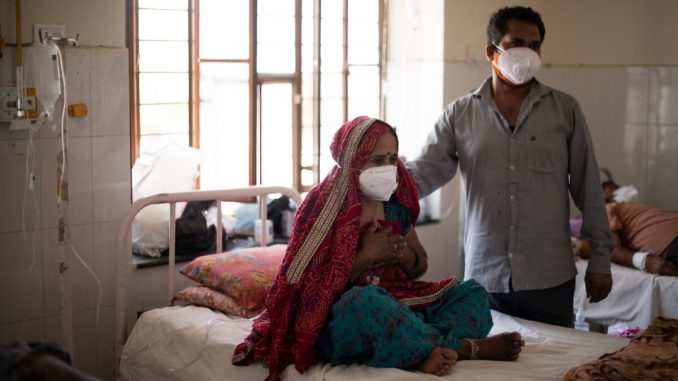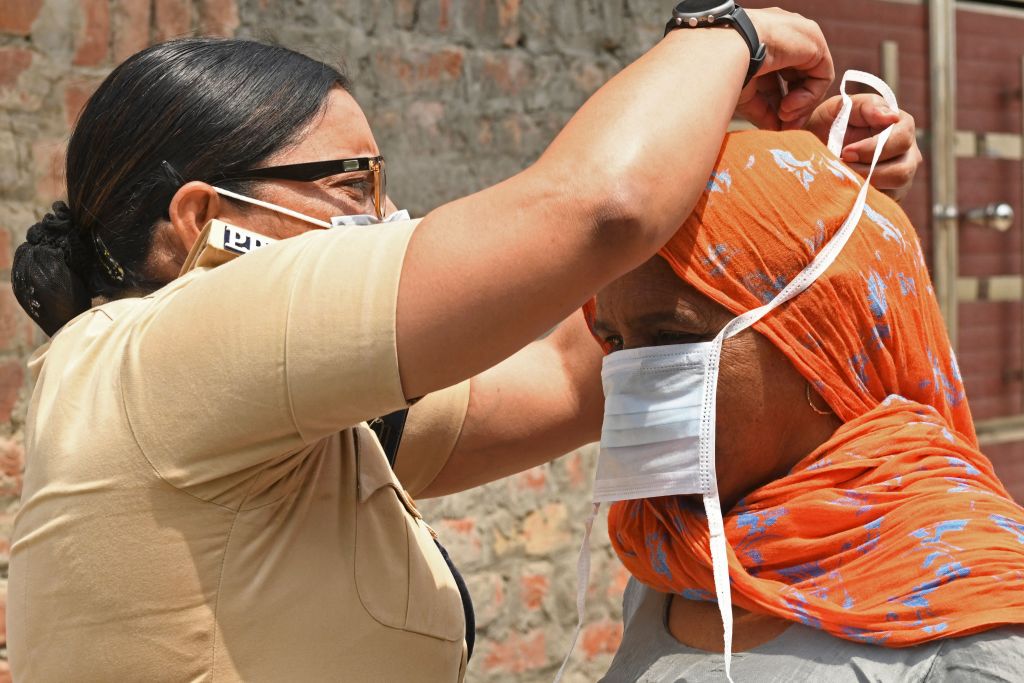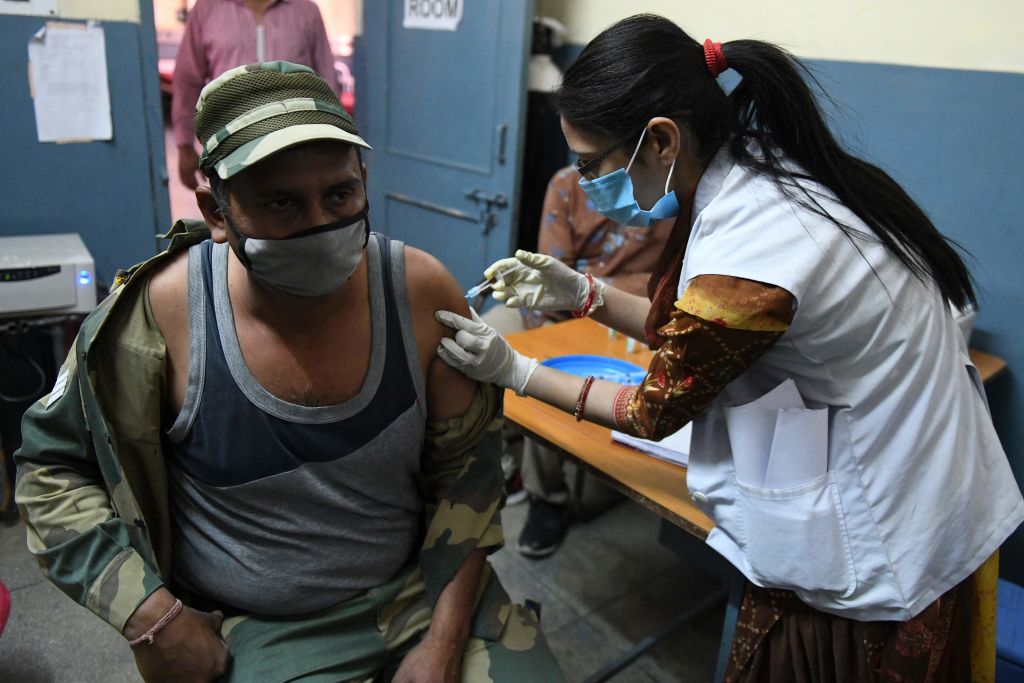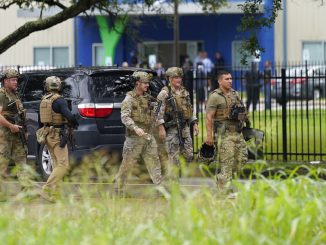
NEW DELHI—While attention has focused on the second wave of the COVID-19 pandemic in India’s major cities, the situation in the vast countryside is becoming worrisome. Those fighting the pandemic point to poverty, lack of awareness, and fear as complicating factors.
Prime Minister Narendra Modi warned in a speech on May 14 that the pandemic is rapidly spreading to rural India and urged citizens to take precautions.
Rural India has over 640,000 villages and over 890 million people, which is more than double the total population of the United States. It’s not only extremely culturally and linguistically diverse but also geographically variegated with some regions closer to urban regions while others are extremely remote, like those in the high reaches of the Himalayas.
“I want to warn you about corona. This pandemic is spreading fast in rural villages. Every government is making efforts to stop this. But awareness of this among rural people and the cooperation of panchayats is equally important,” said Modi.
By “every government” Modi meant the governments of the 28 states and 8 federally governed territories of India, the most populous of them are larger than many European nations. By panchayats he meant the village governing bodies.
The southern state of Karnataka with a population of 64 million reported its highest weekly death toll of 3500 from May 7 to May 13 since the outbreak of the pandemic last year.
When the lockdown was imposed in Karnataka’s capital Bangalore on May 3, over 600,000 moved from the city to their family homes in the countryside, according to Nagasimha G. Rao, the Director of the Child Rights Trust, a charity that works with children and gram panchayats (legally authorized village local governments) in four districts of the state.
Rao said those leaving the capital didn’t follow social distancing when they traveled on public transport, and this worsened the situation in the countryside. In his village Chalatti which is 14 miles from Bangalore city, seven people died during the second wave of the pandemic. Chalati has 105 families and a population of 600 people, when Rao talked with The Epoch Times on Sunday, there were 40 COVID-19 positive people in the village.
“People aren’t coming forward to take tests when they have a fever or other symptoms because they think that if they go to the hospital or for a test and if they put them in isolation and if they die, nobody will come to take the body,” said Rao. Also, everyone doesn’t have masks in villages, he said, and those who have, use the same masks for 2-3 weeks because they can’t afford changing them more frequently.
He said people are getting rice and a few other food items free from the government. Various charities are working in the rural regions, but “awareness is a big problem” for the rural population. He urged the government to give free masks in rural regions.
“The children are also suffering from depression because the news anchors are every day showing the dead bodies, and also patients who are dying in front of the hospital,” said Rao who has been working with children for over two decades and is currently providing psychological counseling over the phone.

More Panic and Fear
Apeksha Suryawanshi, a community worker with a charity called Kalapandri works in three villages in the Lattur district of Maharashtra state in western India. She told The Epoch Times over the phone on Saturday that during the first wave of the pandemic, village communities were taking precautions during the lockdown. During the second wave, there’s more panic and fear among the people.
She said the last time the ASHA (Accredited Social Health Activist) workers were proactively taking villagers for testing while the pandemic was less in severity. This time they are worried about catching the infection themselves and are reluctant to accompany villagers to the testing centers.
“When one person tests positive, they are asked to live in the fields [where they build a makeshift hut]. It has become a kind of rule,” said Apeksha. If someone comes from outside, the villagers on their own initiative, are putting a stamp on them and making them quarantine in the village school.
She said that the government is giving free rice and wheat to people during the second wave but it’s not sufficient as people are forced to live on boiled rice, which is not their staple diet.
Apeksha’s co-worker, Madhukar Galfade who works as a Community Organizer in 13 villages in the Ranapur block of Lattur said that there’s a lot of fear in the countryside about going to the hospital.
“Because those who went, died. So people tend to take medicine at home. Most of the vaccination registration is also online. People in many rural areas still don’t have access to the internet. Until the government reaches every home with the vaccination, it won’t reach people,” said Galfade.
The Epoch Times traveled through the remote hinterland of Lattur through 15 villages for a week in November last year during the first wave of the pandemic to report on the socio-cultural impact of the pandemic in the community. During the second wave, these villages were reached over the phone this week.
During the last pandemic, Maya Sorte was interviewed by The Epoch Times in a school in Chakkur in the district.
A survivor of child marriage herself, Sorte was working to prevent child marriages during the lockdown. Sorte said the second wave has spread so much panic in her region that out of 14 people who died due to COVID in her own village, Wabwal, five died due to heart attacks after learning that they have tested positive.
“People are suffering from panic and illusions. They think if they go to the hospital, they will not get oxygen and they will die,” said Sorte referring to panic due to widespread news of lack of oxygen in the hospitals reported in the media, particularly from the national capital New Delhi during the second wave.
She said in her village Wabwal of 800 families, almost every family has a COVID positive person.

Petition the Government
Vikas Sharma, a wholesale dealer in Bulandshahr, a district in Uttar Pradesh state in northern India, over 60 miles from the capital Delhi, was getting calls from around the rural regions of his city about people with COVID-like symptoms.
So Vikas petitioned the district magistrate and within two days of his call the administration of the district ordered COVID testing in the villages he highlighted.
When the Epoch Times talked with Vikas on May 13, which was over a week since that testing started, more than half the people in those villages had been tested and the positive rate was 10-15 percent, according to him.
“We get calls and people tell us in this village 50 people are sick, in another village 20 people are sick and no one is helping us. We then locate that village, visit it and verify it. We visited one such village, and people told us 12-13 people have died there. We then wrote a letter, got it signed by people, and submitted it with the district administration,” said Sharma adding that he’s daily traveling to 2-3 new villages with his team of 4 people.
Vikas highlighted two villages, Elna and Kelawan, that lost more than 15 people each in a week’s time.
His team has a COVID medicine kit in their car which is recommended by a doctor, and they are linked with a doctor in the city who gives video consultations once the team finds someone in the village with COVID symptoms.
The administration has limited resources and whenever a report or a request comes from somewhere, the resources get utilized there, according to Vikas.
“Even if 5 to 7 or 10 people are sick, they should come forward and demand testing from the local administration,” said Vikas, adding that people shouldn’t take such reports for granted. “If two to four deaths happen in some villages, the people should inform the nearby Primary Health Care center (PHC) and health workers should visit that village to verify the situation.”
There are 23,391 primary health centers and 145,894 sub-centers catering to over 72 percent of India’s rural population, but according to many sources The Epoch Times talked to for this report, the PHCs are ill-equipped to deal with the pandemic.
More than one source interviewed for this story, including Vikas, shared that each PHC on a given day, tests only 25-50 COVID cases and this is not sufficient. The Epoch Times couldn’t independently verify these statistics. “When people force them it may go up to 100,” said Vikas.
Vikas lost his father to COVID last year and he dedicates his work to him. He’s connected to a political party, but he insists that he’s currently coordinating with volunteers from across various political parties and with a charity for COVID relief in villages in Bulandshahr.
“One more problem is of registration for vaccination in villages because of lack of internet literacy,” said Vikas. For the 18-44 years age group the process is online, but for 45 above the registration can also be done on the spot.

Vaccination and Rumors
Neerav Sharma, 32, a lawyer, registered online for vaccination and traveled for the first dose to the Primary Health Center in Kherwara village in Udaipur district in Rajasthan in northwestern India on May 14 along with his brother.
Sharma told The Epoch Times over the phone that they witnessed massive lines to the PHC but there was only one nurse to administer vaccines to everyone. She had fainted at least three times on that day according to witnesses.
“There was no social distancing as the passage to the PHC was narrow for vehicles. There was lots of traffic and rush,” said Sharma adding that it would have been better if a vaccination camp was set up in an open ground with space for social distancing.
Kurpuswamy Raman, the director of READ, a charity that works in 68 villages in Erode district in the southernmost state of Tamil Nadu, said the second wave has created fear and panic.
Raman is happy that the just-elected state government is giving 4000 rupees to every family with a ration card to soften the income loss during the pandemic. He said families have already received 2000 rupees in cash this month and will receive the remaining next month. This is in addition to the free food given to those below the poverty line.
Raman said people are afraid of the pandemic and vaccination and there’s a need for an awareness campaign to mitigate panic and rumors. “They have fear about vaccination. They are not believing because recently one of the cinema actors, Mr. Vivek died one day after taking the vaccination. So there’s a rumor that he got vaccination and that’s why he died,” he said.





Be the first to comment